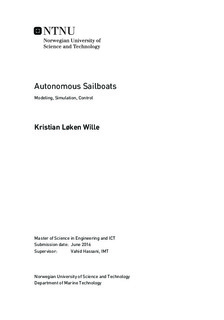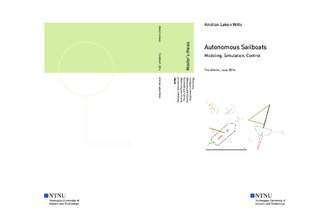| dc.description.abstract | This thesis is divided into five parts. In the first part, a general mathematical model of a sailboat is created. The model presented builds upon previous work and improves the modeling at multiple different areas such as current, wind, the boom dynamics, and more. Simulations are then executed and the results analysed to be used in the controller design.\\
In the next part, an ideal sail and rudder controller is designed on the basis that the system and its states are known at all times. The increased detailed in the simulation compared to previous work presents new challenges, such as how to control the angle of the sail when one only can do so by manipulating the length of a rope connected to the boom. New strategies for a course controller and a technique that reduces roll motion by using the sail are also presented and tested.
\noindent Next, a new and improved path following algorithm is created. Compared to previous works the solution presented is both easy to implement and provides good results. The path following algorithm also takes into account how to chose between tacking or jibing when sailing up-wind, increasing both performance and robustness.
The last two parts are about sensor simulation and state estimation, and how a practical control system can be designed. The practical controller do not have perfect state estimation and is designed to only account for the most important system dynamics, which are determined by using the analysis from the first and second part of this thesis.
Testing shows that every part of the system works as intended. The simulator increases the level of detail and captures new and interesting dynamics. The control system manages to hold a steady course and keep heeling angles within safe levels. The path following allows the sailboat to sail up-wind, and do so without risk of loosing control. The performance of the simple controller is similar to the ideal controller, despite being simpler. | |

